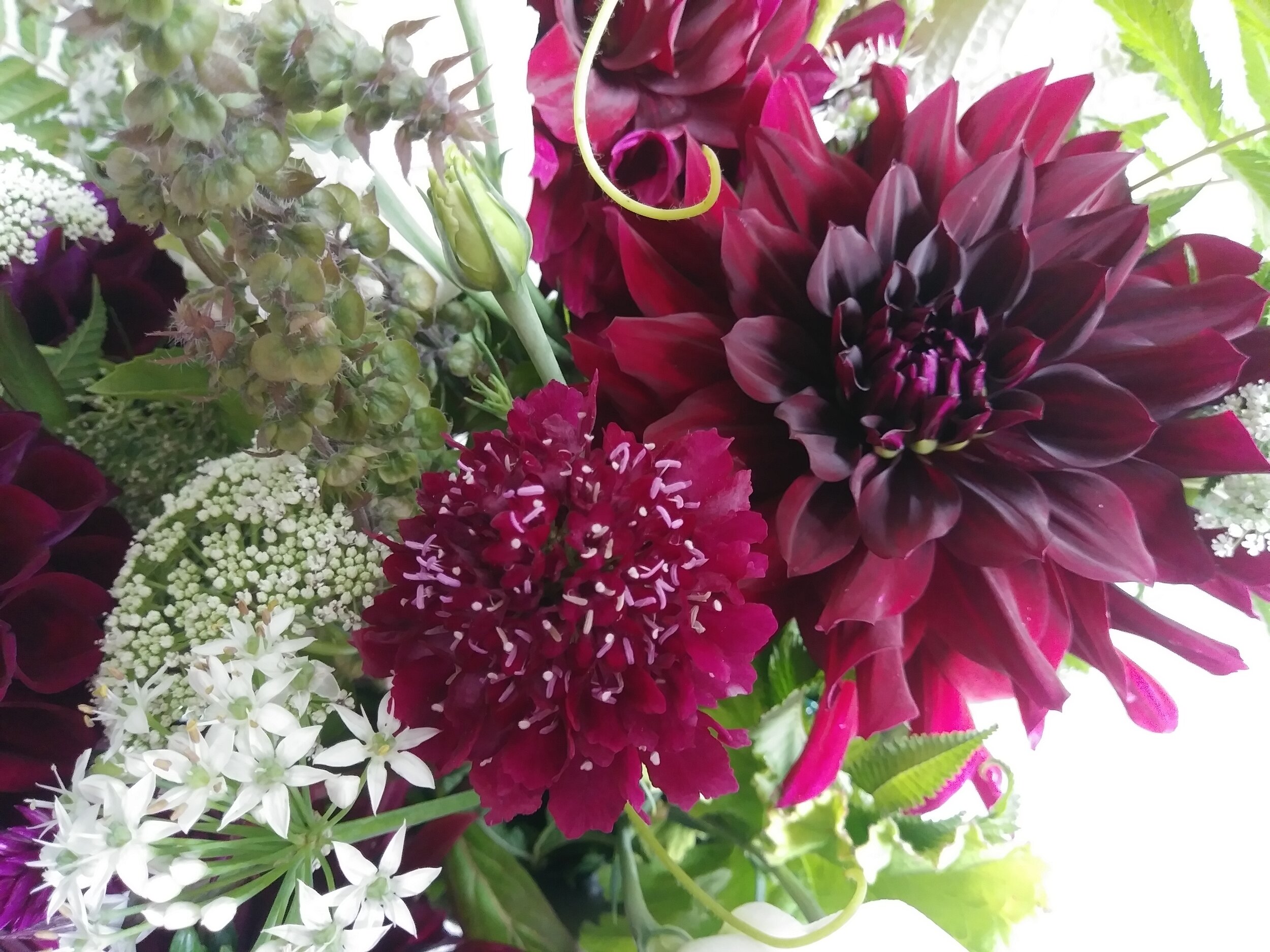How to Grow Scabiosa
How to Grow: Scabiosa
Pronunciation: skab-ee-oh-sah
Few flowers can match the beauty and charm of Scabiosa. These whimsical blooms may not be the biggest or flashiest flowers in the cutting garden, but they are fabulous in bouquets and lovely to behold in the garden.
They are also a favorite of pollinators. On our farm, the Scabiosa patch is a hot spot for butterflies galore!
There are 3 main types of Scabiosa (also called “Pincushion Flower”).
Annual Scabiosa/Pincushion (Scabiosa atropurpurea): This is the most popular type for cutting gardens and the type that will be discussed in this blog post.
Perennial Scabiosa/Pincushion (Scabiosa caucasica): This type is a perennial plant that comes back each year (Zone 3-7). Usually identified by the name “Fama Series”
Starflower (Scabiosa stellata): Annual type grown primarily for its seed heads, not the blooms (pictured below).
“Fama White” Scabiosa (Perennial)
“Starflower” Scabiosa
Let’s look at the Pros and Cons of growing Scabiosa for cut flower use.
PROS
They come in a multitude of colors.
They are easy to grow.
The plants are productive for a long period of time, if continually dead-headed (more about this later…)
They are charming in bouquets.
They have a good vase life of 5 -7 days.
CONS
They bloom profusely and it’s nearly impossible to keep up with deadheading!
They need to be netted or they will fall over.
They get tangled in the netting and can be a real challenge to harvest.
“Merlot Red” Scabiosa
“Snowmaiden” Scabiosa
CHOOSING SEEDS
Most Scabiosa seeds offered by seed companies will “make the cut”.
Here are a few of my favorite Scabiosas to grow for cut flower use:
“Merlot Red” (by far my favorite variety, as the stems are sturdier and less likely to get tangled up)
“Black Night”
“Fata Morgana”
“Snowmaiden”
“Salmon Rose”
“Beaujolais Bonnets”
“Cutbrite Mix”
“Merlot Red” Scabiosa
HOW TO SOW
Scabiosa is a summer blooming flower. They are not frost hardy, so do not plant them too early in the season.
Transplants or Direct Sow?
Scabiosa is versatile and can be transplanted or direct sown.
Transplants are best for most climates. Start seeds indoors about 4 weeks before the last spring frost. Transplant after the risk of frost is over.
Direct sowing is possible. Sow seeds in the ground after the threat of frost is over.
While plants can produce for a long time, they do decline over the season. It’s best to plant 2-3 successions (batches) of seeds, about 3 weeks apart. This ensures you will always have some in bloom.
Scabiosaseed “pods” are a bit odd looking (kind of like little rocket ships!) and people wonder how to plant them. Up? Down? I usually lay them on their side. The actual seed is tiny and hiding inside the weird looking seed “pod”.
PLANT SPACING
Scabiosa should be grown at 9-12” spacing. Be sure to provide some sort of support with netting or the plants will flop over into a tangled mess.
We use Hortnova trellis netting stretched over the bed with stakes. Immediately after planting seeds or transplants, put the netting in place, hovering at about 12-18” high.
“Cutbrite Mix” Scabiosa
GROWING ON
After the transplants are established and growing, it’s helpful to “pinch back” the center stem of the plant when they are less than 8” tall. To pinch, simply use clippers to remove the top of the plant, only leaving 2-3 sets of leaves behind.
Plants that are pinched are more productive than plants that are not. Experiment for yourself - pinch half the plants and leave the other half alone. The un-pinched plants will bloom earlier, but the pinched plants will be more productive.
If flowers are harvested and spent blooms are “deadheaded” (removed), the plants will continue to send up blooms until frost or cold weather arrives.
Keeping up with deadheading is the HARDEST part about growing Scabiosa.
STAGE OF HARVEST
Scabiosa is unique because it can be harvested at several stages. All stages are acceptable and have their charms.
Bud (this is when they really look like a “pincushion”)
Flowering
Seed head (these can look very interesting in arrangements!)
“Cutbrite Mix” Scabiosa
“Merlot Red” Scabiosa
As with all cut flowers, be sure to cut deeply into the plant between 2 sets of leaves, cutting stems at least 18” long. Deep cuts signal the plants to produce MORE flowers to replace the one you just cut.
When you make deep cuts, you will end up with a stem with multiple blooms. This is the easiest and most efficient way to harvest Scabiosa and keep the patch manageable. You may be tempted to cut single blooms, but things will get out of hand quickly if you don’t make deep cuts.
POST HARVEST CARE
Scabiosa requires no special treatment after harvest.
QUESTIONS?
Ask them here and I’ll get back to you!
Ready for More?
If you’re serious about growing the garden of your dreams this year, register for my online course, “Backyard Cutting Garden 101”. You’ll find everything you need to plan, grow, harvest and arrange your stunning blooms. I can’t WAIT to help you grow! Click on the button below for all the details.












